Estimation of Serum Lipid Profile in Gutkha chewers and Oral Sub Mucous Fibrosis patients – A Comparative study
2 Department of Oral and Maxillofacial Pathology, PSM College of Dental Sciences and Research, Akkikavu, Thrissur Kerala, India
Citation: Ealla KKR, et al. Estimation of Serum Lipid Profile in Gutkha chewers and Oral Sub Mucous Fibrosis patients – A Comparative study. Ann Med Health Sci Res. 2017; 7:5: 346-349
This open-access article is distributed under the terms of the Creative Commons Attribution Non-Commercial License (CC BY-NC) (http://creativecommons.org/licenses/by-nc/4.0/), which permits reuse, distribution and reproduction of the article, provided that the original work is properly cited and the reuse is restricted to noncommercial purposes. For commercial reuse, contact reprints@pulsus.com
Abstract
Aim: The role of blood cholesterol level variations in diagnosis and treatment has been extensively worked on in many studies. However, studies on alteration in serum lipid profile among OSMF patients are limited. The present study was performed to estimate serum lipid profile in OSMF patients and gutkha chewers. Material and Methods: The study sample comprised of 45 cases, which included 15 clinically diagnosed OSMF patients (group I), 15 persons with gutkha chewing habit (group II) and 15 controls. The serum levels of Total serum cholesterol (TC), Low Density Lipoproteins (LDL), High Density Lipoproteins (HDL), Very Low Density Lipoproteins (VLDL) and Triglycerides (TG) were analyzed. The data was analyzed using Post hoc Dunnett’s t-test and P<0.05 was studied as statistically significant. Results: On analysis serum lipid profiles progressively lowered in Gutkha chewers and OSMF patients. There was significant decrease in TC (P<0.0001), TG (P<0.0002), LDL (P<0.0007) and VLDL (P<0.0004), HDL (P=16) in gutkha chewers and OSMF patients as compared to controls. Conclusion: This reduction in serum lipid levels can be used as a support for diagnosis and prognosis of oral premalignant and malignant lesions. Further studies with larger sample size and long term follow up and estimation of lipid profiles with regular intervals is required to prove correlation between conversions from precancerous condition to malignancy.
Keywords
Serum lipid profile; Cholesterol; Gutkha chewers; Oral sub mucous fibrosis
Introduction
A biomarker is a substance used to indicate a biologic state. It can be defined as “A substance that is measured objectively and evaluated as an indicator of normal biologic processes, pathogenic processes, or pharmacologic responses to a therapeutic intervention” [1].
Over the past several decades, importance has been placed on revealing molecular markers from saliva, blood, urine and others, for monitoring the cancer progression and detecting, predicting prognosis. Among these markers, variations in blood cholesterol levels in diagnosis and treatment of various diseases have been extensively studied by several workers [2,3].
Oral cancer is the one of the cancer which is associated with Decreased serum lipids. Furthermore, according to some authors low serum cholesterol can be utilized for co-relation of increased risk of cancer occurrence and mortality. In case of oral cancer, tobacco carcinogens induce lipid peroxidation in the tissues, leading to greater utilization of serum lipids for new membrane biogenesis [3-5].
Oral sub mucous fibrosis (OSMF) is a chronic disease of oral cavity in which excessive chewing of areca nut causes fibrosis due to an extensive collagen synthesis. It is predominantly found among the people of South Asia and is closely associated with the habit of gutkha chewing [6-9].
Few studies are available on serum lipid profile in premalignant lesions and conditions particularly in OSMF [3,10,11]. Hence the present study was performed to evaluate changes in serum lipid profile of OSMF patients and gutkha chewers.
Materials and Methods
Study comprised of 45 male patients in the age range of 20-40 years was selected. In the study 15 patients of Oral Sub mucous fibrosis, 15 gutkha chewers and 15 healthy individuals with no systemic disease were selected randomly.
Inclusion criteria
• Clinically diagnosed cases of Oral submucous fibrosis patients were selected as per the criteria by Ranganathan et al.
Exclusion criteria
• Clinically diagnosed cases of Oral submucous fibrosis patients were selected as per the criteria by Ranganathan et al.
Exclusion criteria
• Patients who have undergone or on treatment for oral submucous fibrosis.
• Persons with systemic diseases like diabetes, cardiac problems and thyroid disorders and liver dysfunction.
• Persons with any altered level of cholesterol.
• Persons with any medications (including steroids) that can lower the lipid levels.After acquiring informed consent, Five milliliters of fasting blood was collected from the individual in both the groups (group I and group II ) and controls. The collected blood was then centrifuged and the obtained serum is analysed for lipid profile. Serum lipid profile including cholesterol (C), triglycerides (TG), high density lipoprotein (HDL), low density lipoprotein (LDL) and very low density lipoprotein (VLDL) were evaluated using a chemical analyzer (Erba chem 5x analyzer) based on spectrophotometric principle. The analysis was made by an enzymatic photometric test using a wavelength of 546 nm and an optical path of 1 cm and is known as “CHOD PAP”.
Data obtained was expressed as mean±standard deviation. Analysis of variance (ANOVA) followed by post hoc Dunnett’s t-test was performed for comparison between OSMF patients, Gutkha chewers and controls. P value <0.05 was considered as statistically significant.
Results
Mean, standard deviation, p-value of all lipid profile levels seen in controls, Gutkha chewers, and OSMF patients were calculated and compared. There was a significantly lower levels of mean serum cholesterol (115.6 ± 22.6 mg/dl), TGs (71.7 ± 17.06 mg/dl), HDL (25.86 ± 5.98 mg/dl), LDL (74.67 ± 25.47 mg/dl) and VLDL (14.47 ± 3.5 mg/dl) found in OSMF patients as compared to the controls (cholesterol 163.53 ± 29.75 mg/ dl, TGs 109.7 ± 24.4 mg/dl, HDL 29.93 ± 4.9 mg/dl, LDL 111.67 ± 26.21 mg/dl and VLDL 21.93 ± 4.89 mg/dl) and Gutkha chewers (cholesterol 132.20 ± 22.97 mg/dl, TGs 87.7 ± 26.2 mg/dl, HDL 26.2 ± 7.5 mg/dl, LDL 87.93 ± 22.07 mg/ dl and VLDL 17.4 ± 5.46 mg/dl). In OSMF patients P values suggest that the cholesterol, TGs, LDL and VLDL were highly significant compared to control group. In Gutkha chewers TGs, LDL and VLDL were significant while cholesterol levels were highly significant. In both OSMF patients and Gutkha chewers only HDL (p=16) was not statistically significant compared to control group [Table 1 and Figures 1-6].
| Parameters | Control | Gutkha chewers | Oral sub-mucous fibrosis patients | F-value | p-value |
|---|---|---|---|---|---|
| Cholesterol | 163.53 ± 29.75 | 132.20 ± 22.97** | 115.6 ± 22.6** | 13.85 | P<0.0001 |
| Triglycerides | 109.7 ± 24.4 | 87.7 ± 26.2* | 71.7 ± 17.06** | 10.39 | P<0.0002 |
| HDL | 29.93 ± 4.9 | 26.2 ± 7.5 | 25.86 ± 5.98 | 1.933 | P=16 |
| LDL | 111.67 ± 26.21 | 87.93 ± 22.07* | 74.67 ± 25.47** | 8.7 | P<0.0007 |
| VLDL | 21.93 ± 4.89 | 17.4 ± 5.46* | 14.47 ± 3.5** | 9.65 | P<0.0004 |
* P<0.05, ** P<0.01 compared with control
Table 1: Comparison of lipid profile levels in controls, gutkha chewers and oral sub mucous fibrosis patients using analysis of variance (ANOVA) followed by post hoc Dunnett's t-test.
Discussion
Lipids are cell membrane constituents, essential for various biological functions including cell growth and division of normal and malignant tissues. Lipids also facilitate the maintenance of the structural and functional integrity of all biological membranes [3,12].
It is a well-known fact, that the lipids are high energy releasing molecules. Fats, oils, wax, phospholipids, steroids are few known lipids. At the molecular level, the fats are composed of 1 glycerol and 3 fatty acids known as “triglycerides”. To fulfill the functions of the cell, these triglycerides along with cholesterol circulate in the plasma as lipoproteins [2,12-14].
Recent study conducted by Lohe et al. [15] in 2010 stated that serum lipid levels were inversely associated with the development of precancer and cancer. Biologically, the rapidly dividing cells use more cholesterol reflecting low levels of the same in the blood. By definition, malignancies are characterized by rapidly dividing cells, so low levels of cholesterol can be utilized as early diagnosis in detecting malignancies [9,15,16].
Assessment of lipid profiles in cancers, particularly oral cancer is well studied in the literature. However, studies related to assessment of lipid profiles in gutkha chewers and precancerous conditions such as OSMF are very sparse.
In the present study, significant decrease in serum cholesterol, TGs, LDL and VLDL was observed in Gutkha chewers as compared to the control group except for HDL. On comparison of lipid profile between Gutkha chewers and controls showed a statistically significant difference. Results obtained by our study can’t be compared with other studies, since this is the first study where Gutkha chewers are studied for lipid profile. However Goyal et al. [17]. studied serum lipid levels in tobacco habit group (Smoking and Smokeless) and compared with control group. Results of their study showed that there was no significant difference in the serum lipid profile levels between the gutkha chewing habit group and the controls. Kshitiz et al. [18]. who found raised total cholesterol, LDL, VLDL and, triglycerides and lowered HDL levels in tobacco users.
In the present study, significant decrease in serum cholesterol, TGs, LDL and VLDL was observed in OSMF patients compared to Gutkha chewers and control group except for HDL. On comparison of lipid profile between OSMF patients and controls showed a statistically highly significant difference.
Our study results were similar to the results obtained by Patel et al. [3] and Lohe VK et al. [15]. They showed that a significant decrease in plasma TC and HDL cholesterol was found in both patients with cancer and oral precancerous conditions. Their study also showed lower levels of VLDL cholesterol and TG in cancer as well as in patients with oral precancerous conditions as compared to controls. In contrast, Mehrotra et al. [10]. in their study found a significant increase in total cholesterol, LDL, VLDL, triglycerides levels and significant decrease in HDL.
OSMF is more commonly caused by the use of areca nut and it is a seriously debilitating and progressive disease. In recent years, majority of studies shown a clear link between areca nut chewing and OSMF [16,19].
Gutkha is a mixture of areca nut, catechu, tobacco and slaked lime. Several carcinogens are derived from tobacco and from areca nut. Various studies have been reported that chewing tobacco with areca nut results in high exposure to carcinogenic nitrosamines [20].
During chewing tobacco, Reactive oxygen species (ROS) which are implicated in multistage carcinogenesis are generated in substantial amounts in the oral cavity. However Nair et al. first demonstrated that aqueous extracts of areca nut and catechu were also capable of generating superoxide anion and hydrogen peroxide [11]. The areca nut-induced production of ROS might also lead to lipid peroxidation in OSMF; this in turn can reduce serum lipid levels. Therefore, in the present serum lipid levels were reduced in gutkha chewers and OSMF compared to controls.
These lipid profile alterations in gutkha chewers and OSMF can be attributed to:
• Newly forming and rapidly proliferating cells need many basic components such as lipids well above the normal physiological limits, leading to diminished lipid stores
• Tobacco carcinogens and areca nut present in gutkha generates reactive oxygen species which may be responsible for high rate of oxidation /per oxidation of poly unsaturated fatty acids leading to the alteration of lipid levels
• The inverse relation between decreased serum lipid profile and malignancy/premalignancy was suggested that hypolipidemia may be a late effect occurring during the process of carcinogenesis rather than being the cause.
• These alterations in lipid levels may be a useful indicator for initial changes occurring in neoplastic cells.
• Lastly, this reduction of lipid levels can be used as support for monitoring the prognosis of oral premalignant and malignant lesions.
Alterations in lipid profiles may also depend on multiple reasons, such as age, nutritional status, body mass index, smoking, alcohol consumption, exercise habits and systemic diseases. However in the present study, subjects with proper nutritional status, body mass index were included in the study and subjects who were smoking, alcohol intake and systemic diseases were excluded from the study.
Recently extensively research work on prevention of free radical medicated diseases by using specific antioxidants has been undertaken. Preliminary data indicates protective role of antioxidant supplementation in prevention of premalignancy turning into malignancy [13,20]. Thus this study may be added to the literature indicating that tobacco and areca nut present in gutkha, is so harmful leading to formation of ROS which in turn can reduce the serum lipid levels.
The diagnostic implications of assessing lipid profile in smokers, tobacco and gutkha chewers might be that alteration in lipid profile give us indication that the changes in oral mucosa are taking place to turn into premalignancy or malignancy. Similarly changes in lipid levels if seen in OSMF patients may warrant us to further investigate using different diagnostic aids. Prognostically estimation of lipid levels may facilitate us to monitor the patients who are on treatment. Thus estimation of lipid levels seems to be an easier and faster investigative aid that should be included in routine diagnostic pathology services [12,17,18].
Cancers and Precancers are able to metabolize lipids for their growth and to generate phospholipids membrane. Identification and characterization of more enzymes involved in these pathways will be more imperative for the proper understanding of these steps. Thus advancement in molecular morphology might assist in the near future to identify the inner mechanisms played by enzymes of lipid metabolic pathways especially in OSMF.
Conclusion
The study results showed that lipid profile values were significantly reduced in Gutkha chewers and OSMF patients compared to age and sex matched controls. This reduction of lipid levels can be used as support for diagnosis and prognosis of oral premalignant and malignant lesions. Assessing lipid profile in OSMF has an adjunctive role in diagnosis but it may use as a prognostic indicator. Further studies with larger sample size and long term follow up and estimation of lipid profiles with regular intervals is required to prove correlation between conversions from precancerous condition to malignancy.
Conflict of Interest
All authors disclose that there was no conflict of interest.
REFERENCES
- Mishra A, Verma M. Cancer biomarkers: Are we ready for the prime time. Cancers 2010; 2: 190-208.
- Chawda JG, Jain SS, Patel HR, Chaduvula N, Patel K. The relationship between serum lipid levels and the risk of oral cancer. Indian J Med Paediatr Oncol 2011; 32: 34-37.
- Patel PS, Shah MH, Jha FP, Raval GN, Rawal RM, Patel MM, et al. Alterations in plasma lipid profile patterns in head and neck cancer and oral precancerous conditions. Indian J Cancer 2004; 41: 25-31.
- Savita JK, Girish HC, Murgod S, Kumar H. Oral submucous fibrosis - A review (part 2). J Health Sci Res 2011; 2: 37-48.
- Rajalalitha P, Vali S. Molecular pathogenesis of oral submucous fibrosis - A collagen metabolic disorder. J Oral Pathol Med 2005; 34: 321-328.
- Tilakaratne WM, Klinikowski MF, Saku T, Peters TJ, Warnakulasuriya S. Oral submucous fibrosis: review on aetiology and pathogenesis. Oral Oncol 2006, 42:561-568.
- Pandya S, Chaudhary AK, Singh M, Singh M, Mehrotra R. Correlation of histopathological diagnosis with habits and clinical findings in oral submucous fibrosis. Head Neck Oncol 2009; 1: 10.
- Braakhuis BJ, Leemans CR, Brakenhoff RH. A genetic progression model of oral cancer: Current evidence and clinical implications. J Oral Pathol Med 2004; 33: 317-322.
- Lai DR, Chen HR, Lin LM, Huang YL, Tsai CC. Clinical evaluation of different treatment methods for oral submucous fibrosis. A 10-year experience with 150 cases. J Oral Pathol Med 1995; 24: 402-406.
- Mehrotra R, Pandya S, Chaudhary AK, Singh HP, Jaiswal RK, et al. Lipid profile in oral submucous fibrosis. Lipids Health Dis. 2009; 24; 8:29.
- Nayak P, Nayak S, Darafsh MD. Alteration in plasma lipid profile in precancerous conditions. Journal of Nepal Dental Association 2010; 11:40-45.
- Sharma G, Das D, Mukherjee J, Purandare B. Lipid profile in oral sub-mucous fibrosis patients in India - A pilot study. Indian J Basic Appl Med Res 2013; 7: 790-796.
- Kumar P, Singh A, Sankhla B, Naraniya A. Alteration in plasma lipid profile in oral submucous fibrosis patients: A case control study. South Asian J Cancer 2013; 2: 147-149.
- Gupta S, Gupta S. Alterations in serum lipid profile patterns in oral cancer and oral precancerous lesions and conditions - A clinical study. Indian J Dent 2011; 2: 1-6.
- Lohe VK, Degwekar SS, Bhowate RR, Kadu RP, Dangore SB. Evaluation of correlation of serum lipid profile in patients with oral cancer and pre-cancer and its association with tobacco abuse. J Oral Pathol Med 2010; 39:141-148.
- Ranganathan K, Mishra G. An overview of classification schemes for oral sub-mucous fibrosis. J Oral Maxillofac Pathol 2006; 10: 55-58.
- Goyal S, Vani C, Srikanth K, Lalitha CH. Serum lipid profile in patients with oral tobacco habits and oral precancer lesions and conditions. Webmedcentral Oral Med 2013; 4: 1-10.
- Kshitiz KK, Sinha RB, Bhattacharjee J. A study of effects of smoking on lipid and vitamin C metabolism-A pilot study in Central Bihar. International Journal of Pharma and Bio Sciences 2010; 1:106-113.
- Sudarshan R, Annigeri RG, Vijayabala GS. Pathogenesis of oral submucous fibrosis: The past and current concepts. International Journal of Oral & Maxillofacial Pathology 2012; 3:27-36.
- Nair U, Bartsch H, Nair J. Alert for an epidemic of oral cancer due to use of the betel quid substitute’s gutkha and pan masala: a review of agents and causative mechanisms. Mutagenesis 2004; 19: 251-262.

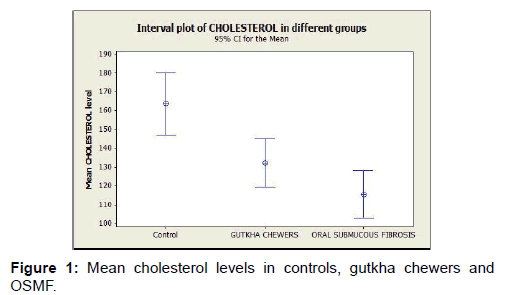
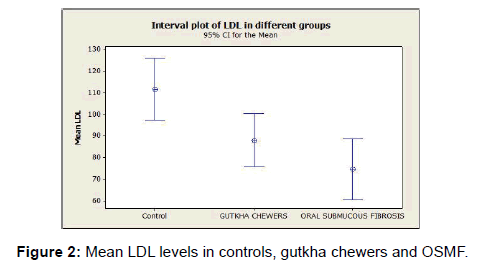
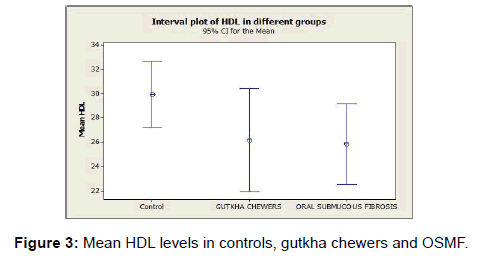
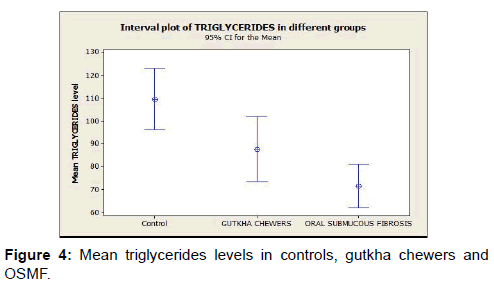
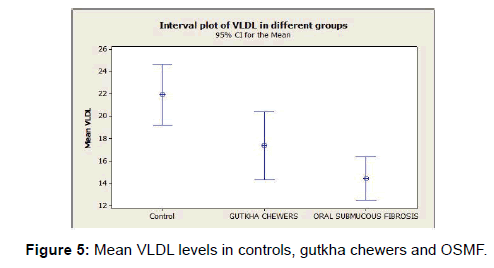
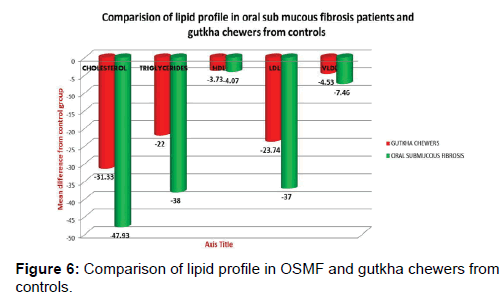



 The Annals of Medical and Health Sciences Research is a monthly multidisciplinary medical journal.
The Annals of Medical and Health Sciences Research is a monthly multidisciplinary medical journal.